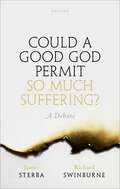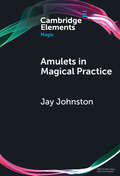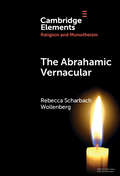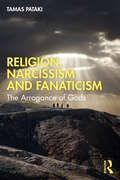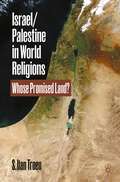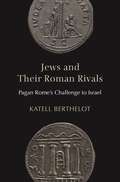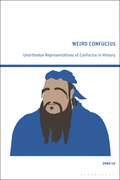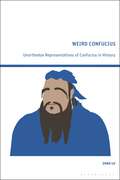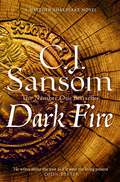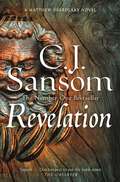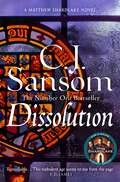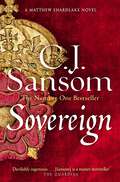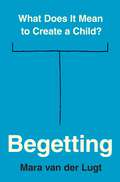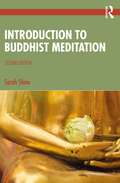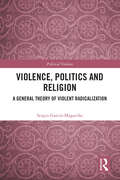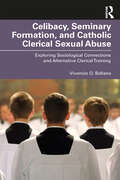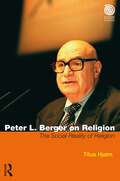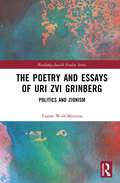- Table View
- List View
Could a Good God Permit So Much Suffering?: A Debate
by James Sterba Richard SwinburneCould a Good God Permit So Much Suffering? presents a debate over whether the degree and amount of moral evil that actually exists in our world is logically incompatible with the existence of the all-good, all-powerful God of traditional theism. James Sterba puts the case in favour of this proposition, on the basis that the evils of the world are so horrendous that their occurrence violates principles requiring the prevention of moral evil, conclusively showing the non-existence of an omnipotent and perfectly good God. In reply, Richard Swinburne argues that our major benefactors, parents and the State, have rights to permit us to suffer if doing so is necessary to secure some good for ourselves or others. Therefore, Swinburne claims, as so much greater a benefactor than are parents and the State, it follows that God has a far greater right to allow suffering to a high degree if allowing such suffering is the only logically possible way for God to secure some very great goods for ourselves or others. Further responses from both Sterba and Swinburne continue the debate, ensuring that all lines of argument are thoroughly explored.
Amulets in Magical Practice (Elements in Magic)
by null Jay JohnstonThis Element takes as its remit the production and use of amulets. The focus will be on amulets with no, or minimal, textual content like those comprising found stone, semi-precious gem and/or animal body parts. That is a material form that is unaccompanied by directive textual inscription. The analysis considers this materiality to understand its context of use including ritual and metaphysical operations. Through discussion of selected case studies from British, Celtic, and Scandinavian cultures, it demonstrates the associative range of meaning that enabled the attribution of power/agency to the amuletic object Uniquely, it will consider this material culture from an interdisciplinary perspective, drawing together insights from the disciplines of cultural studies, religious studies, 'folk' studies, archaeology and Scandinavian studies. It develops the concept of 'trans-aniconism' to encapsulates an amulet's temporal relations and develops the proposition of 'landscape amulets.'
The Abrahamic Vernacular (Elements in Religion and Monotheism)
by null Rebecca Scharbach WollenbergContemporary thought typically places a strong emphasis on the exclusive and competitive nature of Abrahamic monotheisms. This instinct is certainly borne out by the histories of religious wars, theological polemic, and social exclusion involving Jews, Christians, and Muslims. But there is also another side to the Abrahamic coin. Even in the midst of communal rivalry, Jews, Christians, and Muslim practitioners have frequently turned to each other to think through religious concepts, elucidate sacred history, and enrich their ritual practices. Scholarship often describes these interactions between the Abrahamic monotheisms using metaphors of exchange between individuals-as if one tradition might borrow a theological idea from another in the same way that a neighbor might borrow a recipe. This Element proposes that there are deeper forms of entanglement at work in these historical moments.
Could a Good God Permit So Much Suffering?: A Debate
by James Sterba Richard SwinburneCould a Good God Permit So Much Suffering? presents a debate over whether the degree and amount of moral evil that actually exists in our world is logically incompatible with the existence of the all-good, all-powerful God of traditional theism. James Sterba puts the case in favour of this proposition, on the basis that the evils of the world are so horrendous that their occurrence violates principles requiring the prevention of moral evil, conclusively showing the non-existence of an omnipotent and perfectly good God. In reply, Richard Swinburne argues that our major benefactors, parents and the State, have rights to permit us to suffer if doing so is necessary to secure some good for ourselves or others. Therefore, Swinburne claims, as so much greater a benefactor than are parents and the State, it follows that God has a far greater right to allow suffering to a high degree if allowing such suffering is the only logically possible way for God to secure some very great goods for ourselves or others. Further responses from both Sterba and Swinburne continue the debate, ensuring that all lines of argument are thoroughly explored.
Religion, Narcissism and Fanaticism: The Arrogance of Gods
by Tamas PatakiReligion, Narcissism and Fanaticism traces the historical and psychosocial development of religiosity and applies anthropological and psychoanalytic perspectives to the understanding of religions, particularly their fanatical and fundamentalist expressions.Religious ideology, practices and institutions satisfy many human needs, including those arising from our hysterical, obsessional, and narcissistic dispositions: the need to segregate the good and bad aspects of our personalities; to belong to an idealized group; and to feel secure and special by identifying with, or living in the orbit of, a supposedly omnipotent figure. But these needs and their modes of satisfaction are distorted by religions which may then nurture and accommodate malign characteristics, especially in the case of the monotheisms, narcissistic inflation or grandiosity. The book shows how interactions between religious ideology and personal development become intricated in the narcissistic pathology which underlies much of the violence and religious aggression in the world today. It presents both a new account of the historical and psychosocial development of religiosity and a powerful polemic against the religions which delusorily satisfy some of the very needs they create.The book will appeal to psychoanalysts, anthropologists, philosophers, sociologists, and all those interested in the place of religion in the modern world.
Religion, Narcissism and Fanaticism: The Arrogance of Gods
by Tamas PatakiReligion, Narcissism and Fanaticism traces the historical and psychosocial development of religiosity and applies anthropological and psychoanalytic perspectives to the understanding of religions, particularly their fanatical and fundamentalist expressions.Religious ideology, practices and institutions satisfy many human needs, including those arising from our hysterical, obsessional, and narcissistic dispositions: the need to segregate the good and bad aspects of our personalities; to belong to an idealized group; and to feel secure and special by identifying with, or living in the orbit of, a supposedly omnipotent figure. But these needs and their modes of satisfaction are distorted by religions which may then nurture and accommodate malign characteristics, especially in the case of the monotheisms, narcissistic inflation or grandiosity. The book shows how interactions between religious ideology and personal development become intricated in the narcissistic pathology which underlies much of the violence and religious aggression in the world today. It presents both a new account of the historical and psychosocial development of religiosity and a powerful polemic against the religions which delusorily satisfy some of the very needs they create.The book will appeal to psychoanalysts, anthropologists, philosophers, sociologists, and all those interested in the place of religion in the modern world.
Israel/Palestine in World Religions: Whose Promised Land?
by S. Ilan TroenThe struggle over Israel/Palestine is not just another contest by competing nationalisms or an instance of geopolitical competition. It is also about control of sacred territory that involves local Jews, Muslims, and Christians as well as worldwide faith communities, each with their own interests and stake in what transpires. This balanced introduction to a complex subject presents the multiple positions within the great monotheistic traditions. It demonstrates that the secular discourses in the public square concerning ownership privileges, historical precedence, political rights, and justice that have allegedly replaced religious claims actually coexist with, and often complement, the theological. It explores the century-long tangle of secular and theological debates about Israel’s legitimacy. Whether readers support a Jewish state or are resolutely opposed, the serious and substantial scholarship of this well-reasoned and innovative book will contribute to a nuanced and better-informed understanding of this persistent issue that has entered its second century on the international agenda.
Jews and Their Roman Rivals: Pagan Rome's Challenge to Israel
by Katell BerthelotHow encounters with the Roman Empire compelled the Jews of antiquity to rethink their conceptions of Israel and the TorahThroughout their history, Jews have lived under a succession of imperial powers, from Assyria and Babylonia to Persia and the Hellenistic kingdoms. Jews and Their Roman Rivals shows how the Roman Empire posed a unique challenge to Jewish thinkers such as Philo, Josephus, and the Palestinian rabbis, who both resisted and internalized Roman standards and imperial ideology.Katell Berthelot traces how, long before the empire became Christian, Jews came to perceive Israel and Rome as rivals competing for supremacy. Both considered their laws to be the most perfect ever written, and both believed they were a most pious people who had been entrusted with a divine mission to bring order and peace to the world. Berthelot argues that the rabbinic identification of Rome with Esau, Israel's twin brother, reflected this sense of rivalry. She discusses how this challenge transformed ancient Jewish ideas about military power and the use of force, law and jurisdiction, and membership in the people of Israel. Berthelot argues that Jewish thinkers imitated the Romans in some cases and proposed competing models in others.Shedding new light on Jewish thought in antiquity, Jews and Their Roman Rivals reveals how Jewish encounters with pagan Rome gave rise to crucial evolutions in the ways Jews conceptualized the Torah and conversion to Judaism.
Weird Confucius: Unorthodox Representations of Confucius in History
by Zhao LuSpanning antiquity until the present, Zhao Lu analyses the eclectic and fictitious representations of Confucius that have been widely celebrated by communities of people throughout history.While mainstream scholarship mostly considers Confucius in terms of his role as a celebrated man of wisdom and as a teacher with a humanistic worldview, Zhao addresses the weirder representations. He considers depictions of Confucius as a prophet, a fortune-teller, a powerful demon hunter, a shrewd villain of 19th century American newspapers, an embodiment of feudal evils in the Cultural Revolution, and as a cute friend.Zhao asks why some groups would risk contradicting the well-accepted image of Confucius with such representations and shows how these illustrations reflect the specific anxieties of these communities. He reveals not only how people across history perceived Confucius in diverse ways, but more importantly how they used Confucius in daily life, ranging from calming their anxiety about the future, to legitimizing a dynasty, stereotyping Chinese people, and even to forging a new sense of history.
Weird Confucius: Unorthodox Representations of Confucius in History
by Zhao LuSpanning antiquity until the present, Zhao Lu analyses the eclectic and fictitious representations of Confucius that have been widely celebrated by communities of people throughout history.While mainstream scholarship mostly considers Confucius in terms of his role as a celebrated man of wisdom and as a teacher with a humanistic worldview, Zhao addresses the weirder representations. He considers depictions of Confucius as a prophet, a fortune-teller, a powerful demon hunter, a shrewd villain of 19th century American newspapers, an embodiment of feudal evils in the Cultural Revolution, and as a cute friend.Zhao asks why some groups would risk contradicting the well-accepted image of Confucius with such representations and shows how these illustrations reflect the specific anxieties of these communities. He reveals not only how people across history perceived Confucius in diverse ways, but more importantly how they used Confucius in daily life, ranging from calming their anxiety about the future, to legitimizing a dynasty, stereotyping Chinese people, and even to forging a new sense of history.
Dark Fire (The Shardlake series #2)
by C. J. Sansom'C. J. Sansom’s books are arguably the best Tudor novels going' – The Sunday TimesWinner of the CWA Ellis Peters Historical Dagger, Dark Fire is the second thrilling book in C. J. Sansom's number one bestselling Shardlake series, perfect for fans of Hilary Mantel and Philippa Gregory.England, 1540. Out of favour with Thomas Cromwell, Matthew Shardlake is intent on keeping a low profile in the courts. But his involvement with a murder case, defending a girl accused of brutally killing her young cousin, brings him once again into contact with the King’s chief minister – and a new assignment . . .The secret of Greek Fire, the legendary substance with which the Byzantines destroyed the Arab navies, has been lost for centuries. Now an official of the Court of Augmentations has discovered the formula in the library of a dissolved monastery. When Shardlake is sent to recover it, he finds the official and his alchemist brother brutally murdered – the formula gone.Now Shardlake must follow the trail of Greek Fire across Tudor London, while still trying to prove his young client’s innocence. But very soon he discovers nothing is as it seems . . .This is the second novel in C. J. Sansom's gripping historical series. It is followed by Sovereign, the third book in the series.
Revelation: A Matthew Shardlake Tudor Mystery (The Shardlake series #4)
by C. J. Sansom'C. J. Sansom’s books are arguably the best Tudor novels going' – The Sunday TimesRevelation is the haunting fourth book in C. J. Sansom's bestselling Shardlake series, perfect for fans of Hilary Mantel and Philippa Gregory.England, 1543. King Henry VIII is wooing Catherine Parr, whom he wants for his sixth wife. Archbishop Thomas Cranmer and the embattled Protestant faction at court are watching keenly, for Lady Catherine is known to have reformist sympathies.Matthew Shardlake, meanwhile, is working on the case of a teenage zealot detained in the Bedlam insane asylum, and whom he fears could be burned as a heretic. But when an old friend is horrifically murdered, Shardlake determines to bring the killer to justice. His search leads him to Cranmer and Catherine Parr – and to the dark prophecies of the Book of Revelation.As London’s Bishop Bonner prepares a purge of Protestants, Shardlake, together with his assistant Jack Barak and physician friend Guy Malton, uncovers a series of terrible murders which soon bring talk of sorcery and demonic possession – for what else would the Tudor mind make of a serial killer . . . ?This is the fourth novel in C. J. Sansom's thrilling historical series. Continue the series with Heartstone.
Dissolution: Tenth Anniversary Edition (The Shardlake series #1)
by C. J. SansomNow a major Disney+ original series'C. J. Sansom’s books are arguably the best Tudor novels going' – The Sunday TimesDissolution is the first novel in C. J. Sansom’s phenomenal bestselling Shardlake series, perfect for fans of Hilary Mantel and Phillipa Gregory. After one of Cromwell's commissioners is brutally murdered, Matthew Shardlake is drawn into an investigation that becomes darker than he could have ever imagined . . .England, 1537. It is a time of revolution that sees the greatest changes in England since 1066. Henry VIII has proclaimed himself Supreme Head of the Church. The country is waking up to savage new laws, rigged trials and the greatest network of informers it has ever seen. And under the orders of Thomas Cromwell, a team of commissioners is sent throughout the country to investigate the monasteries. There can only be one outcome: dissolution.But on the Sussex coast, at the monastery of Scarnsea, events have spiralled out of control. Cromwell's commissioner, Robin Singleton, has been found dead, his head severed from his body. His horrific murder accompanied by equally sinister acts of sacrilege.Matthew Shardlake, lawyer and long-time supporter of Reform, has been sent by Cromwell to uncover the truth behind the dark happenings at Scarnsea. But Shardlake's investigation soon forces him to question everything that he hears, and everything that he intrinsically believes . . .Follow Shardlake into the dark heart of Tudor England with the next book in the series, Dark Fire.
Sovereign: A Matthew Shardlake Mystery (The Shardlake series #3)
by C. J. Sansom'C. J. Sansom’s books are arguably the best Tudor novels going' – The Sunday TimesFollowing on from Dissolution and Dark Fire, Sovereign is the third gripping historical novel in C. J. Sansom's number one bestselling Shardlake series, perfect for fans of Hilary Mantel and Philippa Gregory.England, 1541. King Henry VIII has set out on a spectacular Progress to the North to attend an extravagant submission by his rebellious subjects in York.Already in the city are lawyer Matthew Shardlake and his assistant Jack Barak, whom have reluctantly undertaken a special mission for Archbishop Thomas Cranmer – to ensure the welfare of an important but dangerous conspirator who is to be returned to London for interrogation.But the murder of a York glazier involves Shardlake in deeper mysteries, connected not only to the prisoner in York castle but to the royal family itself. And when Shardlake and Barak stumble upon a cache of secret documents which could threaten the Tudor throne, a chain of events unfolds that will lead Shardlake to face the most terrifying fate of the age . . .This is the third novel in C. J. Sansom's internationally bestselling Shardlake series. It is followed by Revelation, the fourth book in the series.
Begetting: What Does It Mean to Create a Child?
by Mara van der LugtAn investigation of what it means to have children—morally, philosophically and emotionally&“Do you want to have children?&” is a question we routinely ask each other. But what does it mean to create a child? Is this decision always justified? Does anyone really have the moral right to create another person? In Begetting, Mara van der Lugt attempts to fill in the moral background of procreation. Drawing on both philosophy and popular culture, van der Lugt does not provide a definitive answer on the morality of having a child; instead, she helps us find the right questions to ask.Most of the time, when we talk about whether to have children, what we are really talking about is whether we want to have children. Van der Lugt shows why this is not enough. To consider having children, she argues, is to interrogate our own responsibility and commitments, morally and philosophically and also personally. What does it mean to bring a new creature into the world, to decide to perform an act of creation? What does it mean to make the decision that life is worth living on behalf of a person who cannot be consulted? These questions are part of a conversation we should have started long ago. Van der Lugt does not ignore the problematic aspects of procreation—ethical, environmental and otherwise. But she also acknowledges the depth and complexity of the intensely human desire to have a child of our own blood and our own making.
Begetting: What Does It Mean to Create a Child?
by Mara van der LugtAn investigation of what it means to have children—morally, philosophically and emotionally&“Do you want to have children?&” is a question we routinely ask each other. But what does it mean to create a child? Is this decision always justified? Does anyone really have the moral right to create another person? In Begetting, Mara van der Lugt attempts to fill in the moral background of procreation. Drawing on both philosophy and popular culture, van der Lugt does not provide a definitive answer on the morality of having a child; instead, she helps us find the right questions to ask.Most of the time, when we talk about whether to have children, what we are really talking about is whether we want to have children. Van der Lugt shows why this is not enough. To consider having children, she argues, is to interrogate our own responsibility and commitments, morally and philosophically and also personally. What does it mean to bring a new creature into the world, to decide to perform an act of creation? What does it mean to make the decision that life is worth living on behalf of a person who cannot be consulted? These questions are part of a conversation we should have started long ago. Van der Lugt does not ignore the problematic aspects of procreation—ethical, environmental and otherwise. But she also acknowledges the depth and complexity of the intensely human desire to have a child of our own blood and our own making.
Introduction to Buddhist Meditation
by Sarah ShawThis lively introduction to Buddhist meditation offers students and practitioners alike a deeper understanding of what meditation is and its purpose and place in the context of different Buddhist schools. The historical background and geographical spread of Buddhist meditation is explored alongside an examination of the development of meditative practices. Chapters cover basic meditative practice, types of meditation, meditation in different regions, meditation and doctrine, and the role of chanting within meditation. Although not a practical guide, Introduction to Buddhist Meditation outlines the procedures associated with Buddhist practices and suggests appropriate activities, useful both for students and interested Buddhists. Vivid quotations from Buddhist texts and carefully selected photographs and diagrams help the reader engage fully with this fascinating subject.Thoroughly revised throughout, this new edition also features a glossary and key, making it ideal reading for students approaching the topic of Buddhist meditation for the first time.
Introduction to Buddhist Meditation
by Sarah ShawThis lively introduction to Buddhist meditation offers students and practitioners alike a deeper understanding of what meditation is and its purpose and place in the context of different Buddhist schools. The historical background and geographical spread of Buddhist meditation is explored alongside an examination of the development of meditative practices. Chapters cover basic meditative practice, types of meditation, meditation in different regions, meditation and doctrine, and the role of chanting within meditation. Although not a practical guide, Introduction to Buddhist Meditation outlines the procedures associated with Buddhist practices and suggests appropriate activities, useful both for students and interested Buddhists. Vivid quotations from Buddhist texts and carefully selected photographs and diagrams help the reader engage fully with this fascinating subject.Thoroughly revised throughout, this new edition also features a glossary and key, making it ideal reading for students approaching the topic of Buddhist meditation for the first time.
Violence, Politics and Religion: A General Theory of Violent Radicalization (ISSN)
by Sergio García-MagariñoThis book offers a general theory of violent radicalization and uses case studies from a variety of different countries and groups to illustrate this.The first and fundamental objective of the book is to provide an explanatory framework to understand phenomena related to violent radicalization, deradicalization, the prevention of radicalization and to political violence; in particular, that inspired by religion. The second objective follows from the first. Understanding violent radicalization of religious inspiration implies delving into two key concepts: violent radicalization and religion. This second objective is indeed elusive, since, on the one hand, many liberal democracies have undergone processes of secularization or, at least, have lost interest in examining religion in public debates. Therefore, rigorously exploring social problems where religion seems to be involved, in one way or another, is complicated. Moreover, the notion of violent radicalization, in turn, is highly contested and confused with other ideas, such as polarization, extremism, terrorism or nonviolent radicalization. Finally, the book aims to bring theory into dialogue with empirical phenomena, and to test it against concrete cases related to violent radicalization and its prevention, on the one hand, and religion, on the other. The book’s originality comes from both its innovative, methodological approach and its breadth, with cases from several countries (Spain, the United States, Ireland, India, Israel, Russia and Colombia) and different ideological groups (revolutionary communists, nationalist movements, Jihadist groups, white and black supremacists).This book will be of much interest to students of terrorism and political violence, radicalization, sociology and international relations in general.
Violence, Politics and Religion: A General Theory of Violent Radicalization (ISSN)
by Sergio García-MagariñoThis book offers a general theory of violent radicalization and uses case studies from a variety of different countries and groups to illustrate this.The first and fundamental objective of the book is to provide an explanatory framework to understand phenomena related to violent radicalization, deradicalization, the prevention of radicalization and to political violence; in particular, that inspired by religion. The second objective follows from the first. Understanding violent radicalization of religious inspiration implies delving into two key concepts: violent radicalization and religion. This second objective is indeed elusive, since, on the one hand, many liberal democracies have undergone processes of secularization or, at least, have lost interest in examining religion in public debates. Therefore, rigorously exploring social problems where religion seems to be involved, in one way or another, is complicated. Moreover, the notion of violent radicalization, in turn, is highly contested and confused with other ideas, such as polarization, extremism, terrorism or nonviolent radicalization. Finally, the book aims to bring theory into dialogue with empirical phenomena, and to test it against concrete cases related to violent radicalization and its prevention, on the one hand, and religion, on the other. The book’s originality comes from both its innovative, methodological approach and its breadth, with cases from several countries (Spain, the United States, Ireland, India, Israel, Russia and Colombia) and different ideological groups (revolutionary communists, nationalist movements, Jihadist groups, white and black supremacists).This book will be of much interest to students of terrorism and political violence, radicalization, sociology and international relations in general.
Celibacy, Seminary Formation, and Catholic Clerical Sexual Abuse: Exploring Sociological Connections and Alternative Clerical Training (Routledge Studies in the Sociology of Religion)
by Vivencio O. BallanoDoes the current celibate, semi-monastic, and all-male seminary formation contribute to the persistence of clerical sexual abuse in the Roman Catholic Church?Applying sociological theories on socialization, total institutions, and social resistance as the primary conceptual framework, and drawing on secondary literature, media reports, the author’s experience, interviews, and Church documents, this book argues that the Catholic Church’s institution of the celibate seminary formation as the only mode of clerical training for Catholic priests has resulted in negative unintended consequences to human formation such as the suspension of normal human socialization in society, psychosexual immaturity, and weak social control against clerical sexual abuse. The author thus contends that celibate training, while suitable for those who do live in religious or monastic communities, is inappropriate for those who are obliged to live alone and work in parishes. As such, an alternative model for diocesan clerical formation is advanced.A fresh look at the aptness – and effects – of celibate formation for diocesan clergy, this volume is the first to relate the persistence of Catholic clerical sexual abuse to celibate seminary formation, exploring the structural links between the two using sociological arguments and proposing an apprenticeship-based model of formation, which has numerous advantages as a form of clerical training. It will therefore appeal to scholars and students of religion, sociology, and theology, as well as those involved with seminary formation.
Celibacy, Seminary Formation, and Catholic Clerical Sexual Abuse: Exploring Sociological Connections and Alternative Clerical Training (Routledge Studies in the Sociology of Religion)
by Vivencio O. BallanoDoes the current celibate, semi-monastic, and all-male seminary formation contribute to the persistence of clerical sexual abuse in the Roman Catholic Church?Applying sociological theories on socialization, total institutions, and social resistance as the primary conceptual framework, and drawing on secondary literature, media reports, the author’s experience, interviews, and Church documents, this book argues that the Catholic Church’s institution of the celibate seminary formation as the only mode of clerical training for Catholic priests has resulted in negative unintended consequences to human formation such as the suspension of normal human socialization in society, psychosexual immaturity, and weak social control against clerical sexual abuse. The author thus contends that celibate training, while suitable for those who do live in religious or monastic communities, is inappropriate for those who are obliged to live alone and work in parishes. As such, an alternative model for diocesan clerical formation is advanced.A fresh look at the aptness – and effects – of celibate formation for diocesan clergy, this volume is the first to relate the persistence of Catholic clerical sexual abuse to celibate seminary formation, exploring the structural links between the two using sociological arguments and proposing an apprenticeship-based model of formation, which has numerous advantages as a form of clerical training. It will therefore appeal to scholars and students of religion, sociology, and theology, as well as those involved with seminary formation.
Peter L. Berger on Religion: The Social Reality of Religion (Key Thinkers in the Study of Religion)
by Titus HjelmPeter L. Berger on Religion provides an overview and critical assessment of the work of one of the most influential sociologists of the 20th century.Situating Berger’s writings on religion and secularisation in the broader framework of social constructionism, the book argues that neither he nor the research influenced by him consistently followed the constructionist paradigm. This assessment is informed by a close examination of The Sacred Canopy (1967), in particular. The volume also offers a Berger‑inspired constructionist framework for the study of religion.This book is an excellent resource for students and researchers interested in the intersection of religion and social theory.
Peter L. Berger on Religion: The Social Reality of Religion (Key Thinkers in the Study of Religion)
by Titus HjelmPeter L. Berger on Religion provides an overview and critical assessment of the work of one of the most influential sociologists of the 20th century.Situating Berger’s writings on religion and secularisation in the broader framework of social constructionism, the book argues that neither he nor the research influenced by him consistently followed the constructionist paradigm. This assessment is informed by a close examination of The Sacred Canopy (1967), in particular. The volume also offers a Berger‑inspired constructionist framework for the study of religion.This book is an excellent resource for students and researchers interested in the intersection of religion and social theory.
The Poetry and Essays of Uri Zvi Grinberg: Politics and Zionism (ISSN)
by Tamar Wolf-MonzonThis book focuses on the complex network of relationships between the poet Uri Zvi Grinberg and the Labor Movement in Mandate Palestine from 1923 to 1937.Making use of letters found in the Uri Zvi Grinberg Archive at the National Library of Israel (NLI), the author reconstructs the characteristics of Grinberg’s pioneer readership, attesting to their special relationship with his poetry. In the 1920s, it is argued, they considered Grinberg’s poetry an authentic expression of their complex spiritual world and especially of the reality of their lives. On his side, Grinberg accepted the pioneering ethos as the ideological basis of his works, becoming an outstanding poet of the Labor Movement. The chapters of this book track the various phases of Grinberg’s life and poetry, from his emigration to Palestine through to the 1930s, when he joined the Revisionist Movement and became increasingly ostracized from the Labor Movement. The story of Grinberg’s relations with the pioneers was emotionally charged—a mixture of enchantment and rejection, spiritual closeness and repulsion. Ultimately, this book analyzes the intensity of this connection and its many contradictory layers.This book will interest researchers in a range of fields, including Hebrew poetry and reception theory, as well as anyone interested in Israeli studies and the history of the Labor Movement in Palestine.
